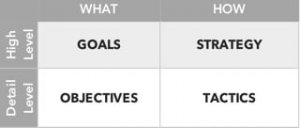
Strategy is one of those words that if you ask ten people what it means you’ll get ten different answers. Add goals, objectives and tactics to the mix and I know we are on different pages. You may be thinking so what? That’s definitely how I looked at this until I listened to Rich Horvath explain them and why they are important. Rich is a strategist who has a knack of explaining all things strategy very simply. It was his GOST model that did it for me.
The GOST Model
The GOST model stands for Goals, Objectives, Strategy and Tactics. There are a few important distinctions in the model. The first is outcomes versus activities, what versus how. These are often confused and that leads to trouble. A goal is a finite outcome and when described as an activity we fall into a big trap. Let me explain with an example. I have a goal to generate more clients. Generating clients is an activity and I have not defined an end state, a goal. The trap is there is no end to amount of work I can do. I much prefer to have a finite goal and do the least work to achieve the desired outcome.
The second distinction relates to the level of detail involved. The GOST model distinguishes between high level and low level details. This is important because we need both consistency of direction and flexibility to change to direction as needed. The high level detail provides that consistent general direction. The low level details are specific and can change without altering the high level general direction.
You can see both distinctions in the following diagram:
Defining GOST elements
Now you understand the framework, let’s define each of the GOST elements:
- Goals – these are high level descriptors of the outcome you wish to create. They are described using broad qualitative terms eg leader, etc. Example: To become the market share leader.
- Objectives – these are the specific outcomes that define your goal. They are often described in specific quantitative measures. Example: Grow segment market share to over 40% before the end of the year.
- Strategy – This is the high level plan you will follow to achieve the goals. Example: Introduce new product and leap frog our competition.
- Tactics – They are specific actions you will take to achieve the goals. Example: Run comparative campaign to advertise product at time of launch.
These simple definitions serve our purpose well. I use the GOST framework to create a simple outline of what I want to do and how I am going to do it. By keeping things simple, I have much more clarity and I find it easier to know where I am going and if I am on track to get there. It is also a brilliant way to explain your goals and plans to others.
Check out the GOST job aid at the link below. It contains a summary of the GOST model and a simple template you can use to put it into action.


